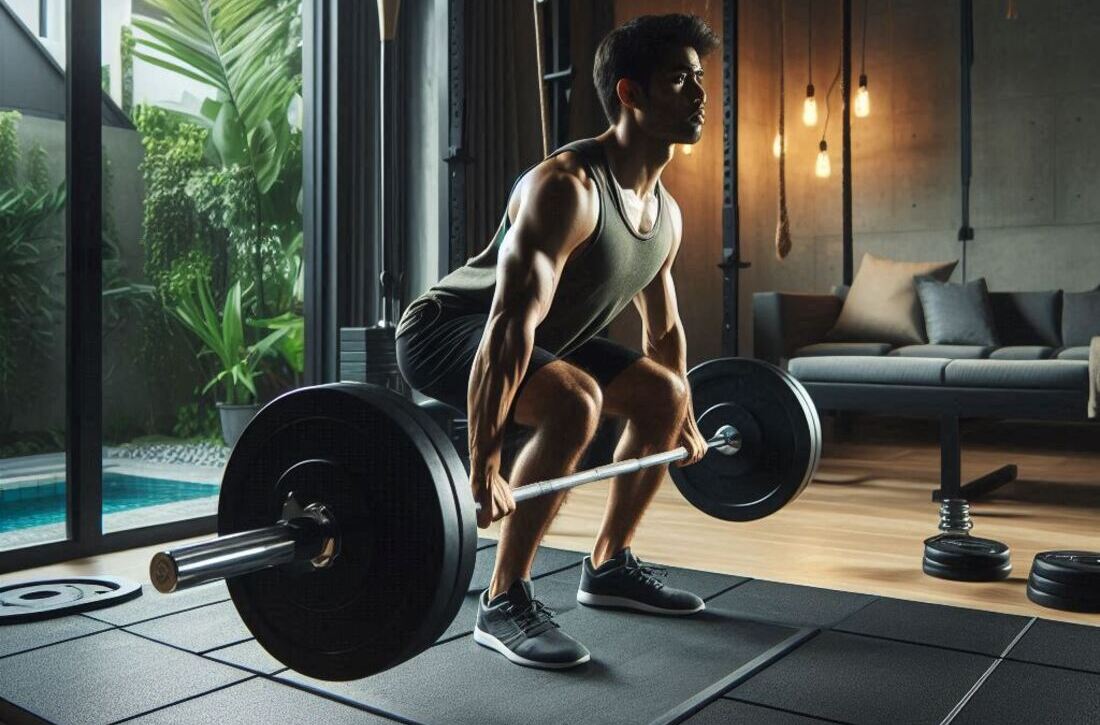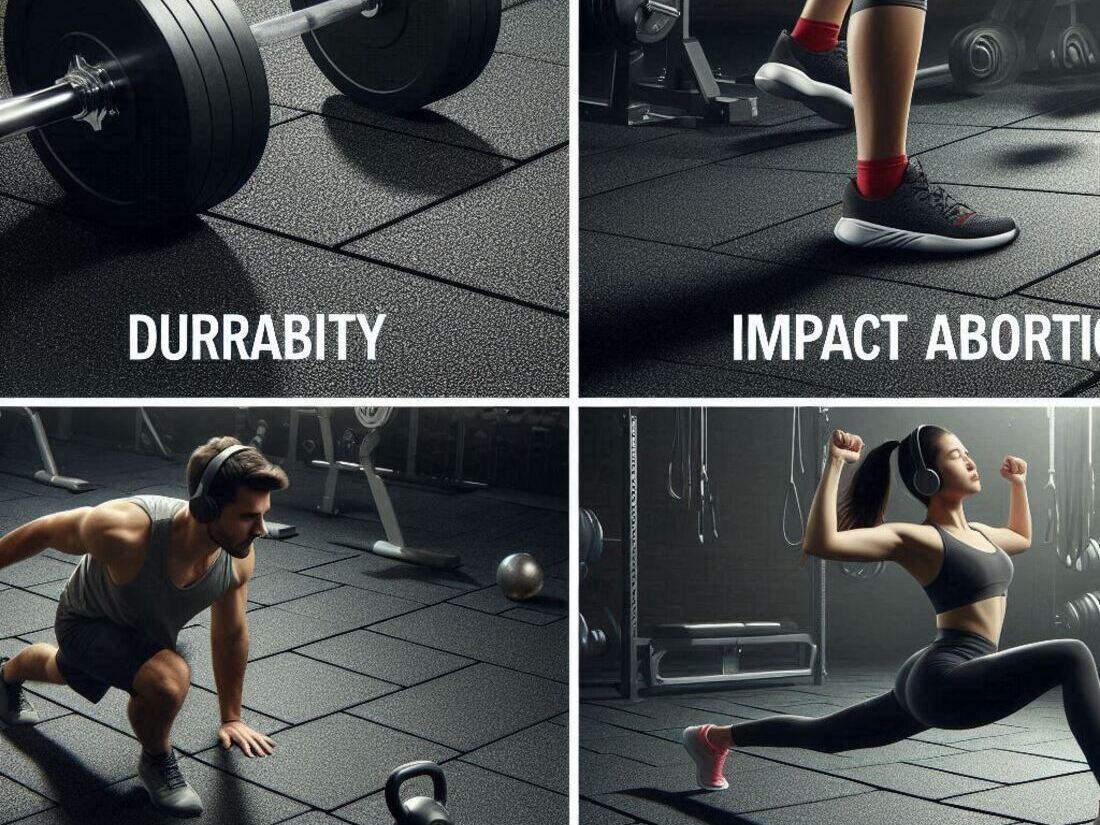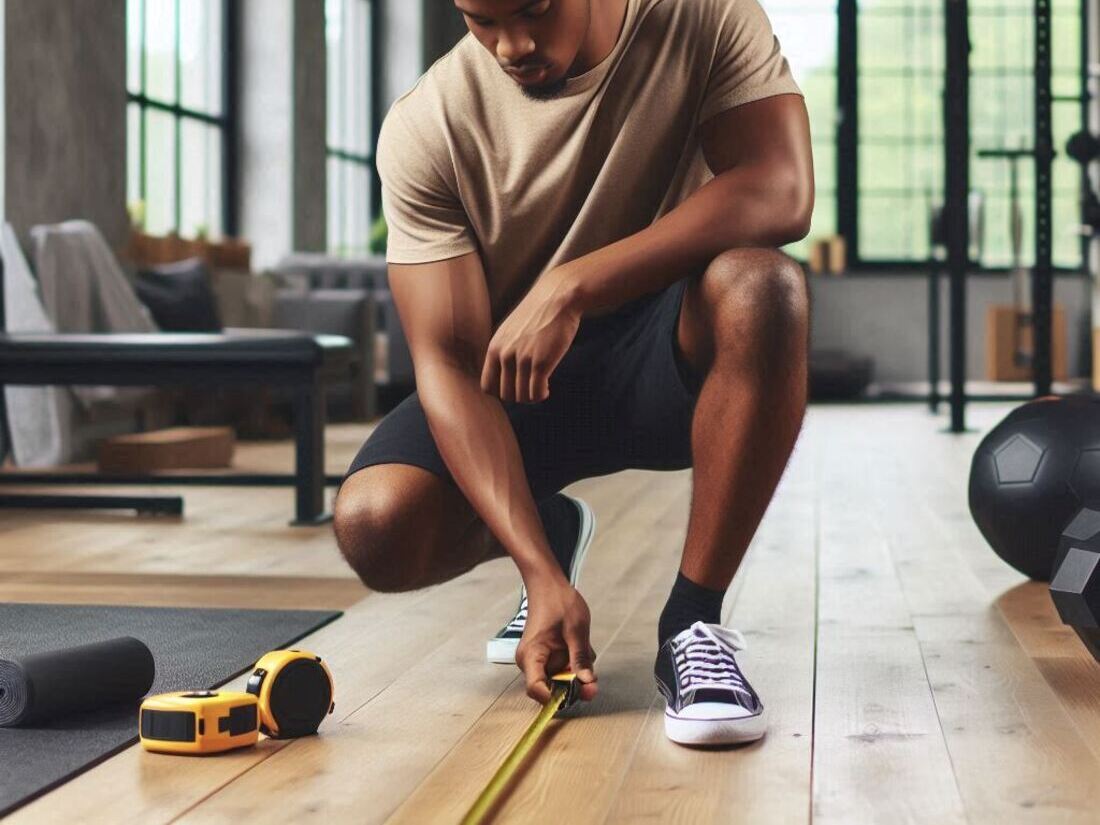You have carved out a dedicated space, invested in top-notch equipment, and you’re pumped to transform your home into a haven for fitness.
But hold on – what’s underfoot?
For a truly functional and safe home gym, the foundation – your flooring – plays a crucial role.

Enter rubber gym flooring, a champion of durability, performance, and safety for all your sweat sessions.
Why is rubber flooring such a popular choice for home gyms?
Let’s delve into the world of rubber tiles, rolls, and mats, exploring their benefits, drawbacks, different types, and everything you need to know to make an informed decision for your home gym flooring.
Why Choose Rubber Gym Flooring?

Here are just a few reasons why rubber flooring reigns supreme in the home gym arena:
- Durability: Rubber is a champion of resilience. It can withstand heavy weights, dropped barbells, and intense workouts without succumbing to wear and tear.
- Impact Absorption: Rubber’s shock-absorbent properties cushion your joints during high-impact exercises like jumping or weightlifting, minimizing stress and potential injuries.
- Sound Dampening: No more disturbing the neighbors with clanging weights or vigorous jump squats. Rubber flooring significantly reduces noise transmission, keeping your workouts quiet and respectful.
- Slip Resistance: Safety first! Rubber’s textured surface provides excellent traction, preventing slips and falls, especially during sweaty workouts.
- Easy Maintenance: Rubber flooring is low-maintenance. Regular sweeping, occasional mopping, and spot cleaning are all it takes to keep your gym floor clean and hygienic.
- Versatility: Rubber flooring comes in a variety of thicknesses, colors, and styles, allowing you to find the perfect fit for your workout space and aesthetic preferences.
Key Takeaways on Rubber Gym Flooring Benefits:
- Durable and resilient – withstands heavy weights and high-impact activities.
- Shock absorption – protects joints and minimizes injury risk.
- Sound dampening – reduces noise transmission for a quieter workout.
- Slip resistance – ensures safety during sweaty or intense workouts.
- Easy maintenance – simple to clean and maintain.
- Versatile – available in various thicknesses, colors, and styles.
Now that you’re sold on the benefits of rubber gym flooring, let’s explore the different types available:
Types of Rubber Gym Flooring
(Note: Affiliate Links)
- Interlocking Rubber Tiles: These puzzle-like tiles are a popular choice for home gyms due to their ease of installation and versatility. They come in various thicknesses and offer a comfortable and secure workout surface.
- Rubber Floor Rolls: Cost-effective and easy to cut to size, rubber rolls are a good option for larger areas. However, proper installation is crucial to avoid unevenness or seams coming apart.
- Rubber Gym Mats: These thicker mats provide excellent impact absorption and are ideal for areas with heavy weights or cardio equipment. They’re also comfortable for floor exercises.
- EPDM Rubber Flooring: Made from recycled rubber granules, EPDM flooring offers a cost-effective option with good durability and sound dampening properties. However, it may not be as aesthetically pleasing as other types.
Table 1: Comparison of Common Rubber Gym Flooring Types
| Type | Pros | Cons | Ideal Use |
|---|---|---|---|
| Interlocking Rubber Tiles | Easy installation, versatile, comfortable | May be more expensive | General gym use, weightlifting, cardio |
| Rubber Floor Rolls | Cost-effective, easy to customize | Requires proper installation | Large areas, weightlifting platforms |
| Rubber Gym Mats | Excellent impact absorption, comfortable | Thicker and may not be as versatile | Weightlifting areas, cardio equipment |
| EPDM Rubber Flooring | Cost-effective, good sound dampening | Less aesthetically pleasing | Budget-friendly gyms, functional areas |
Note: This table is a general guide, and specific products within each type may have varying features.
Important Considerations Before Buying Rubber Gym Flooring

- Thickness: Consider the type of workouts you’ll be doing. Thicker tiles (⅜ inch or above) offer better impact absorption for weightlifting or plyometrics.
- Density: Denser rubber provides superior durability and stability but may be more expensive.
- Surface Texture: Choose a textured surface for improved slip resistance, especially in areas prone to moisture.
- Size and Style: Measure your gym space and choose tiles or rolls that fit your needs. Consider the overall aesthetic and desired color scheme.
FAQs: Frequently Asked Questions About Rubber Gym Flooring

Is rubber gym flooring easy to clean?
Absolutely! Rubber flooring is known for its low-maintenance nature. Regular sweeping to remove dust and debris is sufficient for most situations. For deeper cleaning, occasional mopping with a mild detergent solution is recommended. Avoid harsh chemicals or abrasive cleaners, as they can damage the rubber.
Does rubber gym flooring have a strong odor?
Some new rubber flooring might have a slight rubber smell initially. However, this odor typically dissipates within a few days of installation. Proper ventilation during and after installation can help expedite the process. If the odor persists, consider contacting the manufacturer for recommendations.
Is rubber gym flooring eco-friendly?
There are eco-friendly options available, such as EPDM rubber flooring made from recycled rubber granules. Look for manufacturers committed to sustainable practices and certifications like FloorScore or LEED.
Can I install rubber gym flooring myself?
The ease of installation depends on the type of rubber flooring you choose. Interlocking tiles are generally the simplest, requiring minimal tools and skills. Rubber rolls might require professional installation to ensure proper adherence and avoid seams coming apart. Carefully evaluate your DIY skills and the complexity of the chosen flooring before tackling the installation yourself.
Where can I buy rubber gym flooring?
Rubber gym flooring can be purchased from a variety of retailers, including flooring specialty stores, home improvement stores, and online marketplaces like Amazon. When shopping online, be sure to read product reviews, compare prices and specifications, and choose reputable sellers with clear return policies.
Conclusion: Rubber – The Right Choice for Your Home Gym?
Rubber gym flooring offers a compelling combination of durability, performance, safety, and ease of maintenance, making it a top contender for your home gym.
Consider your workout style, budget, and desired features to choose the perfect type of rubber flooring for your needs.
With its versatility and long-lasting appeal, rubber flooring can provide a solid foundation for your fitness journey for years to come.
Bonus Tip
For added peace of mind, explore rubber gym flooring options with warranties or guarantees on the material and workmanship. This can provide valuable protection in case of any unexpected issues down the line.
Happy Lifting!
Citation
National Floor Covering Association

